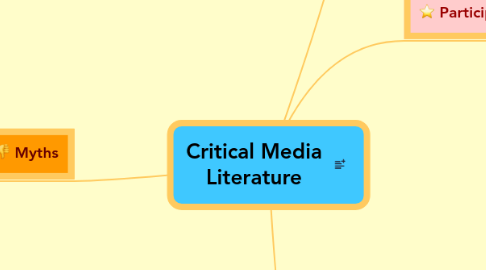
1. Reasons to teach Media Literature
1.1. Students will learn to think critically about the media they are exposed to every day.
1.2. Students will make connections between school and home.
1.3. It will make school relevant to their lives outside of school.
1.4. It will validate technology and show students the importance, power, and influence technology can have.
1.5. It allows students to be creative and show strengths that may typically be missed.
1.6. It will help students make informed decisions and be productive citizens.
2. Myths
2.1. Media Literacy is something else a teacher must make time for!
2.1.1. FALSE!
2.1.1.1. Media Literacy is not an "add on."
2.1.1.2. Teachers can incorporate Media Literacy is all content areas that you are already teaching!
2.2. Traditional reading and writing will be replaced with Multicultural literacy.
2.2.1. FALSE!
2.2.1.1. Traditional reading and writing will not go away. Multicultural literacy will become a part of current programs that will better prepare students for the 'real world.'
2.3. Students are not thinking critically while playing video games, watching TV, or enjoying a movie.
2.3.1. FALSE!
2.3.1.1. Kids are already thinking critically, which is why it is important to utilize these skills in the classroom. These skills can be developed and enhanced.
2.4. The internet cannot enrich learning.
2.4.1. FALSE!
2.4.1.1. Students are deskilled and de-tooled when they are enable to access the internet to obtain information. The web can be a powerful tool, which should be taught how to use and how to think critically.
3. Participatory Culture
3.1. Consumers are producers & Produces are consumers
3.1.1. Collaboration
3.2. Combination of popular culture, technology, and traditional learning.
3.3. Old ways are not enough. Students & teachers need to be part of participatory culture!
3.4. Remix information
3.5. "Collective Intelligence"
3.5.1. Everyone knows something, not all will know everything idea.
3.5.2. Collabrative
3.5.3. Teachers & Students are both learning and teaching.
3.5.4. Social networking
3.6. Subcultures develop
3.6.1. Bloggers
3.6.1.1. Circulation & Sharing
3.6.1.2. Training process
3.6.1.3. Experience & Newbies
3.6.1.4. Feedback
3.6.2. Social Networking
